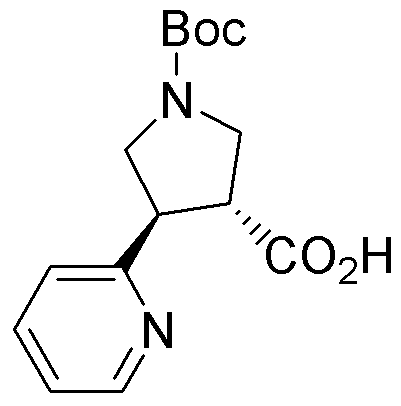Boc-(±)-trans-4-(2-pyridinyl)pyrrolidine-3-carboxylic acid is widely utilized in research focused on:
- Pharmaceutical Development: This compound serves as a key intermediate in the synthesis of various pharmaceuticals, particularly in the development of drugs targeting neurological disorders.
- Peptide Synthesis: It is commonly used in solid-phase peptide synthesis, allowing for the efficient construction of complex peptide sequences with enhanced stability and bioactivity.
- Research in Medicinal Chemistry: The compound is employed in the design of novel ligands for receptors, facilitating the discovery of new therapeutic agents with improved efficacy and selectivity.
- Biochemical Studies: It acts as a valuable tool in studying enzyme mechanisms and interactions, helping researchers understand biological processes at a molecular level.
- Material Science: This chemical is explored in the development of functional materials, such as polymers and coatings, that require specific chemical properties for enhanced performance.
Información general
Propiedades
Seguridad y normativas
Aplicaciones
Boc-(±)-trans-4-(2-pyridinyl)pyrrolidine-3-carboxylic acid is widely utilized in research focused on:
- Pharmaceutical Development: This compound serves as a key intermediate in the synthesis of various pharmaceuticals, particularly in the development of drugs targeting neurological disorders.
- Peptide Synthesis: It is commonly used in solid-phase peptide synthesis, allowing for the efficient construction of complex peptide sequences with enhanced stability and bioactivity.
- Research in Medicinal Chemistry: The compound is employed in the design of novel ligands for receptors, facilitating the discovery of new therapeutic agents with improved efficacy and selectivity.
- Biochemical Studies: It acts as a valuable tool in studying enzyme mechanisms and interactions, helping researchers understand biological processes at a molecular level.
- Material Science: This chemical is explored in the development of functional materials, such as polymers and coatings, that require specific chemical properties for enhanced performance.
Documentos
Hojas de datos de seguridad (HDS)
La SDS proporciona información de seguridad completa sobre la manipulación, el almacenamiento y la eliminación del producto.
Especificación del producto (PS)
La PS proporciona un desglose completo de las propiedades del producto, incluida la composición química, el estado físico, la pureza y los requisitos de almacenamiento. También detalla los rangos de calidad aceptables y las aplicaciones previstas del producto.
Certificados de análisis (COA)
Busque certificados de análisis (COA) ingresando el número de lote del producto. Los números de lote y de partida se pueden encontrar en la etiqueta de un producto después de las palabras "Lote" o "Lote".
Número de catálogo
Número de lote/lote
Certificados de origen (COO)
Este certificado de origen confirma el país en el que se fabricó el producto y también detalla los materiales y componentes utilizados en él y si se deriva de fuentes naturales, sintéticas u otras fuentes específicas. Este certificado puede ser necesario para cumplir con las normativas aduaneras, comerciales y regulatorias.
Número de catálogo
Número de lote/lote
Hojas de datos de seguridad (HDS)
La SDS proporciona información de seguridad completa sobre la manipulación, el almacenamiento y la eliminación del producto.
DownloadEspecificación del producto (PS)
La PS proporciona un desglose completo de las propiedades del producto, incluida la composición química, el estado físico, la pureza y los requisitos de almacenamiento. También detalla los rangos de calidad aceptables y las aplicaciones previstas del producto.
DownloadCertificados de análisis (COA)
Busque certificados de análisis (COA) ingresando el número de lote del producto. Los números de lote y de partida se pueden encontrar en la etiqueta de un producto después de las palabras "Lote" o "Lote".
Número de catálogo
Número de lote/lote
Certificados de origen (COO)
Este certificado de origen confirma el país en el que se fabricó el producto y también detalla los materiales y componentes utilizados en él y si se deriva de fuentes naturales, sintéticas u otras fuentes específicas. Este certificado puede ser necesario para cumplir con las normativas aduaneras, comerciales y regulatorias.


